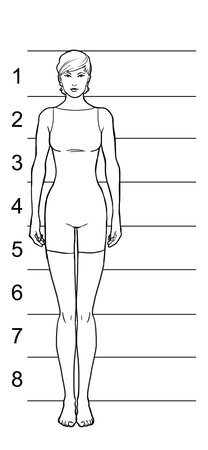Proportion—The Secret of All Well-Dressed People
Episode #6 of the course Lazy person’s guide to a perfect wardrobe by Andrea Pflaumer
You’ve seen them…or maybe you’re one of them. They are the women whose jeans puddle around the ankle over their sneakers or whose A-line skirts hit at mid-calf. They are guys whose Bermuda shorts end at the knee and whose tee shirts hang below their bum. They are the people whose clothes always look a little large, a little long, a little…awkward.
These faux pas aren’t just the realm of the lazy or the less financially endowed. You could buy the most expensive cashmere overcoat, but if it isn’t cut right for your proportions, you will always look poorly dressed.
So today, we’re going to talk about one of my favorite subjects: the science and mathematics of proportional dressing.

The human body is divided up, roughly, into eight head lengths. That means that if you were to measure the distance from your chin to your top of your head, you would most likely be eight times that tall. (Of course, there are variations on this. Professional fashion models are usually about eight-and-a-half head lengths tall.)
Let the Eye Travel
One of the biggest fashion mistakes people make is to wear pieces that divide their bodies in half. That means one demarcation point at the hip (four head lengths) and the other at the ankle (another four head lengths). It’s a stagnant image.
What you want to do is create an image that “moves.” Former editor for Bazaar magazine Diana Vreeland said, “The eye has to travel.” Here are a few simple rules to make the eye travel.
1. Think “odds”: Create outfits that are divided at odd number points, e.g. three head lengths for a top, five for a bottom. Or, five head lengths for a dress or coat. Just create some kind of visual break from the four-and-four structure. If the overall image includes division points made up of odd numbers, the eye will move. If you do wear a hip length jacket, have it somewhat nipped in at the waist or worn open to reveal a belt at the waistline.
2. Balance volume: If two pieces are cut equally wide at the shoulder, hip, and hemline, you will look like a box. To create better proportions, if you wear something larger on the upper part of your body, make the bottom part more fitted; if you wear something fitted on the upper part of your body, wear something with more volume on the lower half. If you wear two fitted pieces on the upper and lower part of your body, you can add an outerwear piece that has more volume. Just keep it proportionally “odd”—have the hemline or break point be three or five head lengths.
3. Pay attention to scale: This refers to the amount of volume in your garments. The simple rule is: “Am I wearing this…or is it wearing me?” Do not swim in your clothes. Do not suffocate in them. Don’t let your tee shirt, overcoat, handbag, briefcase, or jewelry upstage you. Pay attention to the size of the things you wear or carry. Are you large? Go for larger accessories and greater volume. Are you tall? Go for longer lengths. Are you short or petite? Look at everything from armhole sizes to handbag width to necklace lengths. (You can still wear “statement” accessories, as long as they are in the proper scale to the rest of your outfit.)
If you are clueless about your own proportions and the ideal hemlines or visual break points in garments that work for you, consult with a good tailor or stylist. Elegantly dressed people understand the best proportions for their bodies—or they have an excellent tailor who will do this for them. That’s what we cover in Lesson #8.
Tomorrow, we’re going to explore how to shop intelligently.
Recommended book
100 Years of Fashion by Cally Blackman
Share with friends

